INTEGRAL celebrates a decade of discoveries
17 October 2012
ESA's INTEGRAL mission is celebrating the tenth anniversary of its launch, which took place on 17 October 2002. Over the past decade, the mission has observed the entire sky at hard X-ray and soft gamma-ray energies with unprecedented sensitivity and resolution, shedding new light on several classes of astronomical sources, galactic and extragalactic alike. Highlights of the mission so far have included the study of the emission from electron-positron annihilation across the sky, the discovery of two previously unknown classes of X-ray binaries, the characterisation of the cosmic X-ray background and the first detection of polarisation in gamma-ray sources. |
| INTEGRAL launch. Credit: ESA/ S. Corvaja |
Europe's window to the very high-energy Universe, ESA's International Gamma-Ray Astrophysics Laboratory (INTEGRAL) celebrates its tenth anniversary in space on 17 October. Launched in 2002 from the Baikonur Cosmodrome in Kazakhstan, INTEGRAL has been monitoring the sky in a previously poorly investigated portion of the electromagnetic spectrum. Sensitive to both hard X-rays (between 3 and 35 keV) and soft gamma rays (from 15 keV to 10 MeV), the mission has been a valuable bridge between traditional X-ray telescopes, which observe the sky at lower-energy X-rays, and the space- and ground-based experiments that concentrate on high- and very high-energy gamma rays.
"With its two main instruments, the Imager on Board the INTEGRAL Satellite (IBIS) and the SPectrometer on INTEGRAL (SPI), this was the first mission to combine wide-field imaging and fine spectroscopy over a broad range of energies in the hard X-ray and soft gamma-ray bands," comments Chris Winkler, INTEGRAL project scientist at ESA.
"The imager and spectrometer are both based on the coded-aperture mask technique, and they are also suited for measurements of polarisation - something that had not been performed at these energies thus far," he adds. INTEGRAL also carries an X-ray monitor, JEM-X, and an optical monitor, OMC, that provide complementary data on the sources that are observed at higher energies with IBIS and SPI.
Based on the unique combination of its instruments, INTEGRAL has been providing astronomers with a new view of the entire sky in hard X-rays and soft gamma rays for almost ten years. By revealing both the diffuse emission from our Galaxy, the Milky Way, and the population of individual sources that shine brightly at these energies, INTEGRAL has broadened our understanding of several classes of sources, galactic and extragalactic alike. Here are some of the most significant results achieved by the mission over the past decade.
Diffuse emission from electron-positron annihilation
One of the most intriguing signals that can be detected in the portion of the spectrum probed by INTEGRAL is the characteristic emission feature produced by the annihilation of electrons with their antiparticles, positrons. Detecting antiparticles is a notoriously hard task, as the Universe is dominated by matter rather than antimatter, and any antiparticle that may be produced will eventually disappear by colliding with its corresponding particle, releasing photons as a result. In the case of electrons and positrons, the resulting emission consists of a distinctive line at 511 keV and a continuum emission spectrum up to 511 keV.
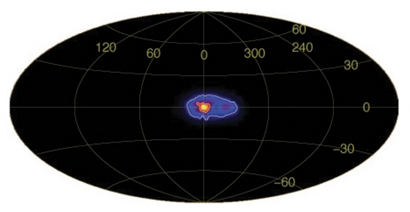 |
| Map of the entire sky at 511 keV. Credit: ESA/INTEGRAL/MPE (G. Weidenspointner et al.)< |
Emission from electron-positron annihilation was first detected with balloon experiments in the 1970s, but only with INTEGRAL has it been possible to map this signal across the entire sky. These unique data have revealed that the 511-keV emission appears to be centred towards the bulge of the Milky Way, but also shows a weaker signal aligned with the Galactic disc. In addition, INTEGRAL data revealed an asymmetrical distribution of this emission, which is almost twice as strong on one side of the Galactic Centre as on the other. The reason for such an asymmetry is still the subject of investigation. The morphology of the 511-keV emission across the sky does carry information about its sources, although this information may be partly lost if positrons travel across the Galaxy before annihilating.
Theory suggests that natural sites for the production of positrons are stellar explosions, but there are several other candidates. These range from X-ray binaries - binary systems comprising a compact remnant, such as a neutron star or a black hole, which accretes matter from a stellar companion - to the annihilation of dark matter particles. It is also possible that the configuration of the Galactic magnetic field has a strong impact on the morphology of the 511-keV emission, causing positrons to travel long paths before colliding with electrons and disappearing.
"The shape of the 511-keV line measured with INTEGRAL shows that the electrons and positrons responsible for this emission are being annihilated in warm gas. This suggests that they have travelled across the interstellar medium from the much hotter sites of their production. Their origin, however, still remains unclear," notes Winkler.
Discrete galactic sources: X-ray binaries
Over the years, INTEGRAL has scanned the entire sky, leading to the compilation of a rich catalogue that comprises more than 700 point sources across the sky, both galactic and extragalactic in nature. The majority of the previously unknown sources in this catalogue have been identified, by comparison with observations at other wavelengths. Many of the sources detected by INTEGRAL were already known to astronomers, but in various cases they had never before been resolved in hard X-rays or soft gamma rays.
| The Galactic Bulge as viewed by INTEGRAL between April 2007 and October 2011. Credit: ESA/INTEGRAL/JEM-X/IBIS/Optical image: ESO & S. Brunier Click here for more information on this video. |
During its monitoring of the sky, INTEGRAL has focussed on the centre and the bulge of our Galaxy. There, the vast majority of high-energy sources correspond to the final products of stellar evolution: either neutron stars or black holes in X-ray binaries, or pulsars - highly magnetised, spinning neutron stars. In particular, the extensive data collected with INTEGRAL have revealed two new classes of high-mass X-ray binaries (HMXB), binary systems where the companion star providing matter to the accreting compact remnant is a bright and massive star (either an O or B star, a Be star or a blue supergiant).
"One of the first puzzling sources uncovered by INTEGRAL, named IGR J16318-4848, had all the characteristics of an X-ray binary but, surprisingly, it had never been observed in lower-energy X-rays," explains Winkler.
"After the discovery with INTEGRAL, the X-ray counterpart to IGR J16318-4848 was sought and found: it turned out to be so faint that it had eluded all previous searches at soft X-ray energies."
Further observations across the spectrum revealed that IGR J16318-4848 is what astronomers call a highly obscured X-ray binary: an HMXB where the donor star is a supergiant whose wind embeds the compact remnant - in this case a neutron star - and absorbs its radiation even at soft X-ray energies. This peculiar object was in fact just the first of a new class unveiled by INTEGRAL, which has discovered a total of about 35 highly obscured X-ray binaries.
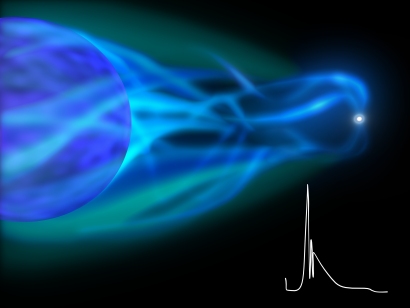 |
| Artist's impression of a Supergiant Fast X-ray Transient. Credit: ESA |
Another baffling type of HMXB discovered with INTEGRAL are the so-called supergiant fast X-ray transients (SFXTs). These sources were first noticed because of their occasional flares in X-rays: this transient activity, which lasts only a few hours, enhances the brightness of these otherwise very faint sources dramatically. Over the years, INTEGRAL has discovered about 25 SFXTs.
"The discovery of short-lived phenomena such as SFXTs was possible thanks to the high sensitivity of INTEGRAL and to its long monitoring campaigns of the Galactic centre," explains Winkler.
"The origin of the outbursts in SFXTs is still debated, but is possibly linked to the accretion process that powers these X-ray binaries, where the compact remnant is fed by a clumpy stellar wind. Normally, the accretion proceeds at very slow rates and the source is relatively faint; the flares correspond to the compact remnant suddenly engulfing a denser patch of the stellar wind," he adds.
Extragalactic sources: Active Galactic Nuclei, the Cosmic X-ray Background and Gamma Ray Bursts
Over 250 of the extragalactic point sources detected with INTEGRAL have been identified as active galactic nuclei (AGN). These are galaxies hosting a central, supermassive black hole that is actively accreting matter; the accretion process causes AGN to radiate profusely across the electromagnetic spectrum. The hard X-ray energy band is particularly important for the study of AGN since the emission at these energies is dominated by non-thermal emission mechanisms. An example is the Compton scattering of lower-energy, soft X-ray photons, which are released by the accretion disc that feeds the supermassive black hole and later bounce off electrons in the surrounding plasma, gaining energy in the process. Emission from AGN in the soft gamma-ray band is also crucial to study the powerful jets of relativistic particles that stem from the vicinity of the supermassive black hole.
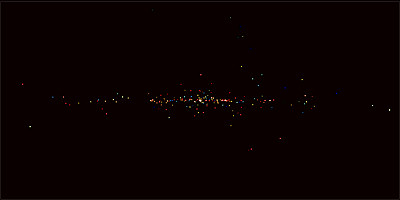 |
| The entire sky seen at hard X-ray energies with the IBIS instrument on INTEGRAL. Credit: ESA/F. Lebrun/CEA Saclay, Service d'Astrophysique |
"Another advantage of observing AGN in the portion of the spectrum probed by INTEGRAL is that this emission is hardly absorbed. This is not the case for lower energy photons, which may experience strong absorption by intergalactic material that enshrouds the central black hole," notes Winkler.
"Sources that appear radically different in soft X-rays because of different degrees of absorption, exhibit a very similar behaviour when observed with INTEGRAL. We can thus use hard X-ray observations to survey the sky for heavily absorbed sources that might otherwise be missed," he says.
The study of AGN at hard X-ray energies is critical in the investigations of the nature of the Cosmic X-ray Background (CXB), a tenuous, diffuse radiation that pervades the X-ray sky from all directions. In fact, this background radiation peaks at the hard X-ray energies probed by INTEGRAL. By comparing the CXB to the stacked emission of a sample of nearby AGN as detected by INTEGRAL, a team of astronomers has demonstrated that the CXB consists of the cumulative X-ray radiation emitted by all unresolved active galaxies.
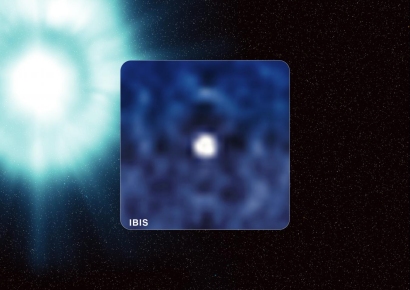 |
| A gamma-ray burst: artist's impression (left) and an image from INTEGRAL/IBIS (centre). Credit: ESA/SPI Team/ECF |
Another class of extragalactic sources that astronomers target with INTEGRAL are the famous gamma-ray bursts. A Gamma Ray Burst (GRB) is an intense flare of gamma rays that may last only a few seconds or minutes. These bursts are tell-tale signals from the most powerful explosions in the cosmos; some of them are believed to be linked to supernova explosions and others to the merging of two neutron stars. Along with other space telescopes, INTEGRAL is involved in the search for GRBs. As soon as a burst is detected by a gamma-ray telescope, an alert is sent to a large network of ground- and space-based observatories to follow it up. At longer wavelengths, the dimmer afterglow of a GRB can be observed for a longer amount of time, allowing astronomers to gather more information about the source, such as its distance.
"From the beginning of its operations, INTEGRAL has detected almost 90 GRBs," says Winkler.
Detection of polarised emission
One of INTEGRAL's unique instrumental features is the ability to perform measurements of polarisation in the gamma-ray band on astronomical sources other than the Sun. This is made possible by the configuration of its two instruments - IBIS and SPI - which both consist of a number of individual detectors that are separated from one another. Photons which are emitted by a cosmic source and reach one of these instruments interact with more than one detector: they are initially scattered by one of the detectors and then absorbed by another one. If the cosmic radiation was polarised, then the distribution of photons recorded by the detectors carries an imprint of such polarisation. Measuring polarisation is, however, an extremely delicate task: since the polarised component represents only a fraction of the total radiation emitted by the source, it is best detected in the case of very bright sources.
Using this technique, astronomers have detected polarised emission in three sources observed with INTEGRAL. The first detection of polarised gamma rays was achieved using data from the brightest source in the high-energy sky: the Crab Nebula, a supernova remnant consisting of a nebula with a pulsar at its core. The polarised component of the nebula's emission, revealed by INTEGRAL, appears to be aligned with the rotation axis of the pulsar, thus demonstrating that gamma rays are emitted in the vicinity of the central source - and possibly by the jets that stem from it.
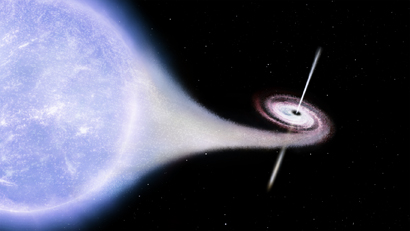 |
| Artist's impression of Cygnus X-1. Credit: ESA |
Further studies of INTEGRAL data revealed polarised emission from another bright X- and gamma-ray source: the X-ray binary Cygnus X-1, consisting of a black hole that accretes matter from a supergiant blue star. The detection of polarisation in the gamma-ray emission from this system helped astronomers to locate the origin of the most energetic radiation in this kind of binary, demonstrating that the gamma rays arise from the jets of relativistic particles that stem from the vicinity of the black hole.
Polarisation was observed also in GRB 041219A, one of the GRBs detected with INTEGRAL. Although the gamma-ray emission from a GRB declines quickly - in this case, the burst only lasted a few seconds - the extremely intense brightness of the source allowed the astronomers to detect polarisation in the gamma-ray signal coming from the explosion. Given the very large distance of the source, located almost 300 million light-years away from Earth, a team of astronomers has exploited these data to study how the light emitted by the source has propagated across the Universe before reaching us. In fact, if light rays with different polarisation states were to travel at slightly different velocities, as a result of the Lorentz invariance violation, this would leave a distinctive imprint on the data collected by INTEGRAL. Lorentz invariance violation is a symmetry breaking predicted in some of the theories that unify gravity and quantum physics. The study based on INTEGRAL data revealed no such effect: if such a symmetry violation is at play, it must occur at much higher energies than previously thought. The study also set a limit for the fundamental length scale of quantum gravity, which has to be smaller than 10-48 m.
"By observing polarisation in this energy range for the first time, INTEGRAL has opened a new window to study the powerful and exotic phenomena that take place in the high-energy Universe," notes Winkler.
"This has improved our understanding of fascinating astrophysical objects such as pulsars and black holes, and is even allowing us to test fundamental physics," he concludes.
Notes for editors
INTEGRAL is an ESA project with instruments and science data centre funded by ESA Member States (especially the Principal Investigator countries: Denmark, France, Germany, Italy, Spain, Switzerland) and Poland, and with the participation of Russia and the USA.
Contacts
Chris Winkler
INTEGRAL Project Scientist
Research and Scientific Support Department
Directorate of Science and Robotic Exploration
ESA, The Netherlands
Email: cwinkler rssd.esa.int
rssd.esa.int
Phone: +31-71-5653591


